Your cart is currently empty.
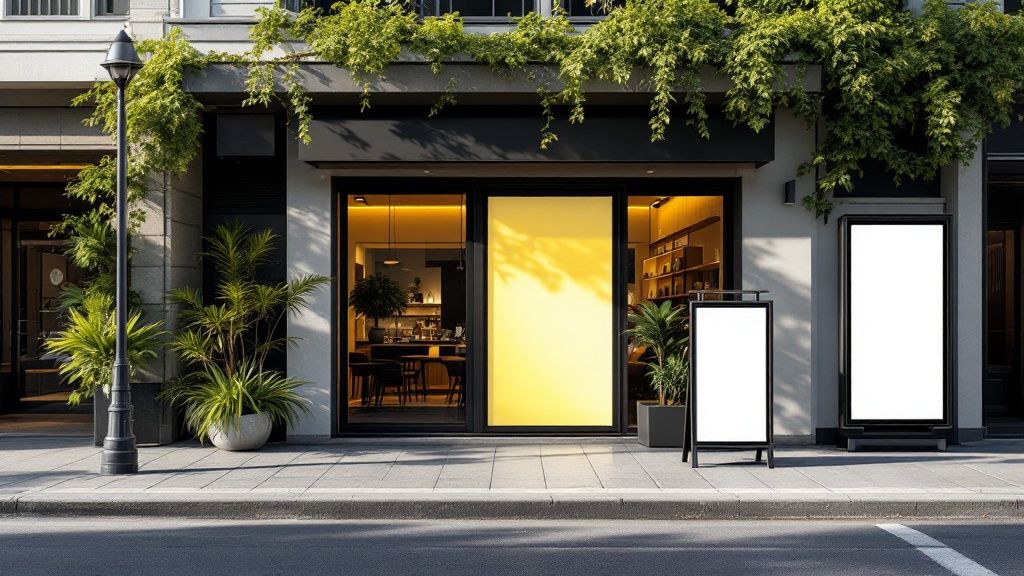
Picking the right signage for sale is about more than just a quick purchase. It’s a genuine investment in your brand’s visibility and how people see you for the first time. This guide is here to cut through the jargon and show you what really counts when choosing a sign that not only looks fantastic but actually brings in business.
How to Choose the Right Signage for Your Business
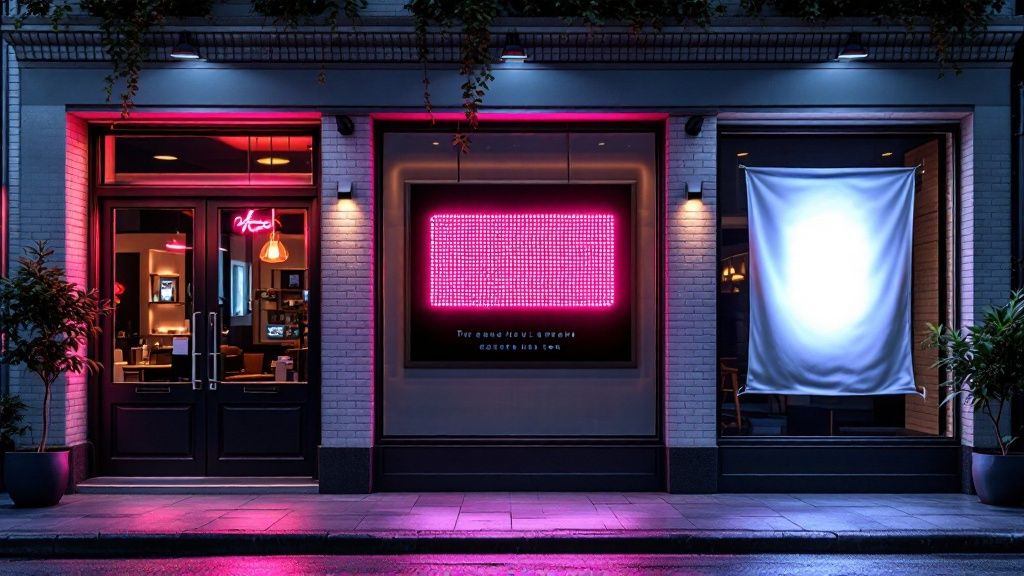
Think of your business sign as your best salesperson—one that works 24/7. It's constantly on the job, grabbing the attention of passersby, showing off your brand's personality, and making you stand out from the crowd. For many people, it's the very first time they'll interact with your business, so its impact is huge. Putting your money into the right sign is easily one of the smartest marketing moves you can make.
In New Zealand, the signage industry is a major player in advertising, especially in what's known as out-of-home (OOH) advertising. In fact, the OOH market in New Zealand is projected to hit around US$117 million in 2025. That number alone shows just how vital physical advertising has become in a crowded marketplace. It's a clear signal of the power that high-quality, well-placed signs have.
Making a Strategic Choice
Choosing the perfect sign is a balancing act. You need to weigh up a few key things to make sure it does its job properly. Before you even start looking at signage for sale, it pays to have a clear game plan.
Your sign isn’t just another business expense; it’s a long-term investment in your brand’s identity. A great sign can pay for itself many times over by consistently pulling in new customers and cementing your place in the community.
To make a decision you'll be happy with for years to come, start by thinking about these fundamentals:
- What's the Main Goal? What do you really need this sign to do? Is it about screaming your location from down the street, tempting pedestrians with a great deal, or simply building your brand?
- Who Are You Talking To? Think about your ideal customer. The style, colours, and the words you use should all connect with them, whether you're targeting high-end corporate clients or local families.
- Where Will It Go? An outdoor sign has to be tough enough to handle New Zealand’s unpredictable weather, while an indoor sign might be more about looking sharp and stylish. Don't forget to consider how it will look from different distances and angles.
This guide will walk you through the most common types of signs, what to look for when choosing, and how you can make it your own. By the time you're done, you’ll have the confidence and knowledge to pick a sign that turns heads and helps your business grow.
What Are My Options? A Look at the Main Types of Business Signs
When you start searching for signage for sale, it can feel a bit overwhelming. There are so many choices. The best way to think about it is like putting together a great team – each type of sign has a specific job to do, and knowing their strengths is key to building a winning marketing strategy.
Some of the most tried-and-true options are the ones that work hard for you every single day at street level. These are your reliable workhorses, grabbing the attention of people walking or driving past your front door.
Your Everyday Advertising Champions
Let’s start with the signs you see everywhere. There's a reason for that: they just work. Think of these as the friendly face of your business, offering a warm welcome and inviting people inside.
- A-Frame Signs: These are your classic sidewalk greeters. Pop one outside your entrance, and you’ve got the perfect tool for flagging daily specials, announcing a sale, or simply pointing people in the right direction. Because they’re so portable, you can move them around for maximum impact.
- Banners: Banners are the sprinters of the sign world—fast, effective, and built for short-term impact. They're brilliant for shouting about a grand opening, a special event, or a limited-time promotion, giving you a huge canvas for a bold message without breaking the bank.
- Shop Front Signs: This is your permanent handshake with the world. Fixed to your building, it cements your identity and makes you easy to find. A well-designed shop front sign is a long-term investment, building brand recognition 24/7.
This simple breakdown shows how custom signs don't just look good; they deliver real, measurable results by making you more visible, building a memorable brand, and encouraging customers to step inside.
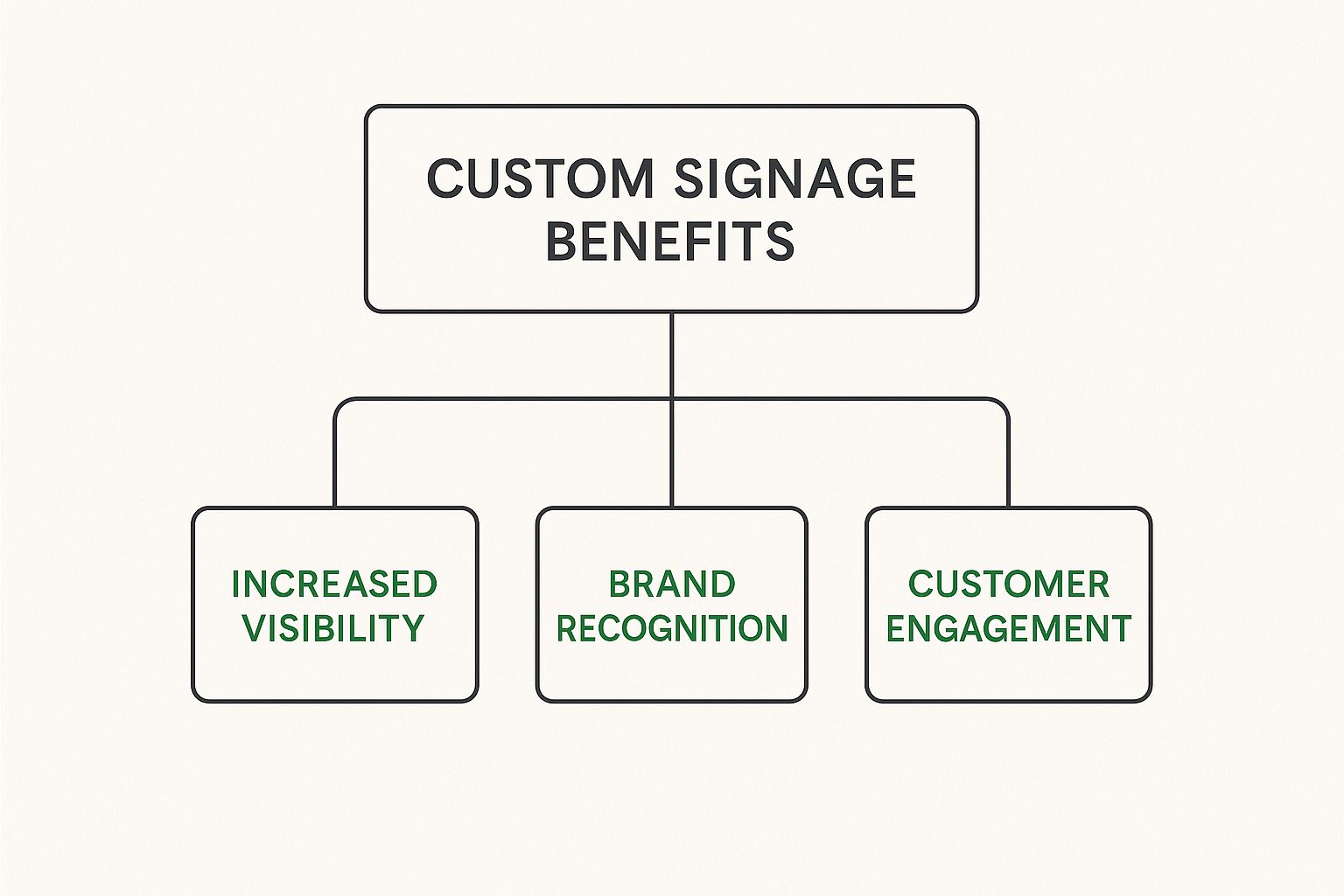
As you can see, these benefits are all connected. Better visibility leads to stronger brand recognition, which in turn creates more meaningful interactions with your customers. It's a powerful cycle.
To help you get a clearer picture, here’s a quick comparison of these common signage types.
Comparing Common Signage Types at a Glance
This table provides a quick comparison of popular signage options to help businesses decide which type best fits their needs based on common use cases, typical lifespan, and primary benefits.
| Signage Type | Best Use Case | Typical Lifespan | Key Benefit |
|---|---|---|---|
| A-Frame Sign | Pavement advertising, daily specials, wayfinding | 1-3 years | High portability and versatility |
| Banner | Events, sales, grand openings | Short-term (months) | Cost-effective for temporary promotions |
| Shop Front Sign | Building identification, primary branding | 5-10+ years | Long-term brand establishment |
| Lightbox | 24/7 visibility, high-traffic areas | 5-10+ years | Excellent day and night visibility |
| Vehicle Wrap | Mobile advertising, fleet branding | 3-7 years | Reaches a massive, widespread audience |
This table should make it easier to see how each option fits a different piece of the marketing puzzle.
High-Impact and Mobile Solutions
Once you’ve got your fundamental signs sorted, you can start looking at more dynamic options to really kick your marketing up a notch. These signs are all about capturing attention in powerful ways and extending your brand’s reach far beyond your front door.
Illuminated signs, for instance, are a total game-changer. A lightbox acts like a beacon for your business, shining bright day and night. It guarantees your brand stays visible long after you’ve locked up, leaving a lasting impression on anyone passing by. For businesses on busy streets, that constant visibility is pure gold.
Another incredibly effective approach is to turn your company vehicle into a moving billboard. Vehicle wraps transform a car or van into a 24/7 advertising machine. Every single trip, whether you're heading to a job or just popping to the shops, becomes a marketing tour, putting your brand in front of thousands of potential new customers all over town.
What's Next in Signage?
The world of signs is always moving forward, and digital options are becoming more affordable and popular than ever. Digital displays give you incredible flexibility, letting you update your message with just a few clicks. This isn't just a local trend; the global digital signage market is growing at a compound rate of about 8.1% each year and is on track to hit $31.7 billion by 2025. This worldwide shift is directly influencing the types of signage for sale right here in New Zealand. You can dive deeper into these digital signage trends to see what they could mean for your business.
Critical Factors to Consider Before You Buy
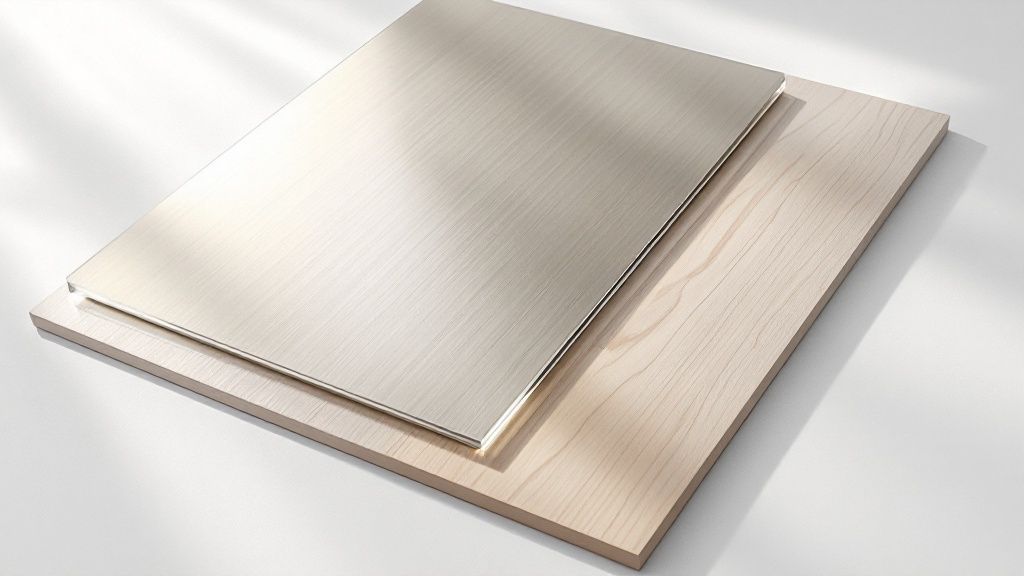
Buying a sign is a bit like buying a car. You wouldn't pick a two-seater convertible for the school run, and the same thinking applies here. Getting the right signage for sale means looking past the design and thinking hard about where and how it will be used. A smart choice here will pay dividends for years to come.
The first, and arguably most important, decision is location. Where will the sign actually live? This single question dictates everything from the materials you’ll need to how long you can expect it to last. An indoor sign in a cozy retail shop is shielded from the weather, giving you the freedom to choose more delicate materials or complex designs.
An outdoor sign in New Zealand, on the other hand, is a completely different story. It has to be tough enough to handle everything our climate throws at it – from harsh UV rays and salty sea air to driving rain and winter frosts. A sign for a café on the Coromandel coast, for instance, needs to be made from corrosion-resistant materials to stand up to the sea spray. That's not even a consideration for an office sign in inland Hamilton.
Navigating Local Council Rules
Before you get too far down the track, you need to have a chat with your local council. It’s a step many business owners miss, but you can’t just put any sign you like wherever you want. Local bylaws are often quite specific about the size, placement, and even the lighting your sign can have.
As a general rule, if you’re planning something large, illuminated, or a sign that sticks out from your building, you’ll almost certainly need a permit. Skipping this step can lead to hefty fines or, even worse, being ordered to take your brand-new sign down. A quick call to the council’s planning department at the start will save you a world of headaches, time, and money later on.
A sign that looks amazing but doesn't comply with local regulations is an expensive mistake. Checking with your council first is one of the smartest moves you can make.
Maintaining Your Brand Identity
Lastly, think about how the sign fits in with your overall brand. Your signage isn't just a marker; it’s a physical piece of your brand identity. Consistency is what builds that instant recognition and trust with your customers.
Make sure your sign uses the same core elements as the rest of your marketing.
- Colour Palette: Stick to your exact brand colours to keep your visual identity strong.
- Fonts: The typography should be the same as what’s on your website, business cards, and flyers.
- Logo: Your logo needs to be front and centre, displayed clearly and without being stretched or squashed.
When all these elements work together, you create a seamless and professional look. The goal is for someone to see your sign and feel an immediate sense of familiarity, strengthening their connection to your business. A great sign doesn't just point the way; it tells a piece of your brand's story.
Choosing the Right Signage Material for the Job
Picking the right material for your sign is a lot like choosing the right tool for a job. You wouldn't use a sledgehammer to hang a picture frame, right? In the same way, the material you choose for your signage is crucial—it directly affects its appearance, how long it will last, and what it's going to cost. Getting this right means your investment not only looks sharp but also holds up to whatever the environment throws at it.
Think of some materials as sprinters, perfect for short-term, high-impact campaigns. Others are more like marathon runners, built to go the distance. Knowing the difference is the secret to getting real value when you're looking at signage for sale.
Built for the Sprint: Short-Term Options
When you need something for a temporary promotion, a one-off event, or a real estate listing, you're looking for a material that's easy on the wallet and easy to handle. This is where options like Corflute really shine.
- Corflute: This is the undisputed champion for temporary outdoor signs. Its corrugated plastic design is incredibly light, simple to move around, and surprisingly tough against a bit of rain and wind. That's why you see it everywhere for event signage and on construction sites.
- Vinyl: Supremely versatile, vinyl is the go-to for banners, decals, and window graphics. It’s a brilliant and affordable way to blast a vibrant, full-colour message for a specific sale or event without needing it to last forever.
Built for the Marathon: Long-Term Durability
For signs that need to be a permanent part of your building, especially outdoors, you need materials that are built tough. These are the workhorses of the signage world, engineered to handle New Zealand's famously unpredictable weather year after year.
A fantastic example is Aluminium Composite Material (ACM). It's made of two thin aluminium sheets sandwiching a solid plastic core. This creates a sign that’s strong, perfectly flat, and incredibly resistant to the elements. It won’t rust, bend, or fade easily, which makes it ideal for shop fronts and directional signs that have to look immaculate for a decade or more.
Choosing a durable material like ACM or acrylic isn't just a purchase; it's an investment in your brand's consistency. It ensures that first impression stays sharp and professional, protecting your image from the effects of time and weather.
Other premium, long-lasting materials offer their own unique advantages. Acrylic, for instance, gives you that sleek, high-gloss finish for a modern, sophisticated vibe—perfect for corporate reception areas. For a truly timeless and permanent statement, nothing beats the elegance and endurance of cast metal plaques. If you're considering this classic option, a detailed guide to cast aluminum plaques can offer great insight into their durability and aesthetic fit for different businesses. At the end of the day, matching your specific need with the right material is what makes a sign perform brilliantly.
Bringing Your Brand to Life with Custom Design
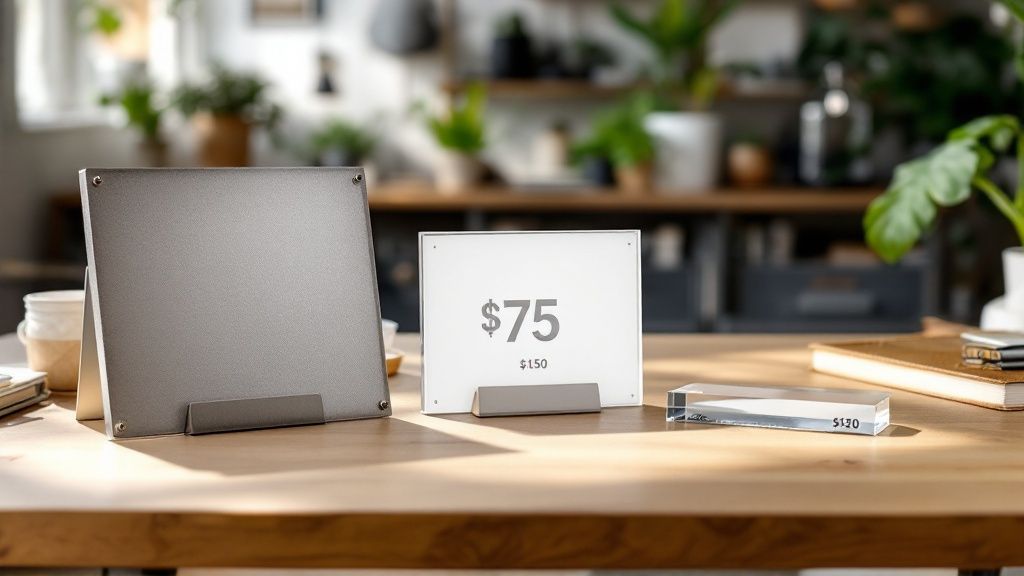
Think of your sign as more than just a marker—it's your brand’s handshake with the world. Custom design is what turns your business's unique personality into a physical object that grabs attention and tells your story. It’s the critical process where your logo, colours, and core values are crafted into that all-important first impression.
But a great design is about more than just aesthetics; it's about function. Every single element needs to be chosen with a purpose. Is the font easy to read from across the street? Do the colours create the right feeling? Is your logo positioned to be easily seen and remembered? Get these details right, and your sign transforms into a hard-working asset for your business.
To make sure your signage is a true extension of your identity, it’s a great idea to pair it with professional brand design services. This ensures everything looks and feels consistent, creating a seamless identity that builds real trust with your customers.
From Concept to Creation
Taking a design from a digital file to a finished physical product involves a few different manufacturing methods, and each one gives a completely different result. The technique used can totally change the final impact of your sign, so it helps to know what’s available when you start looking at signage for sale.
Here are some of the most common production methods you'll come across:
- Digital Printing: This is your go-to for vibrant, full-colour graphics on flat materials like ACM or Corflute. It’s perfect for signs that need to show off detailed logos or photographic images.
- Vinyl Cut Lettering: If you're after crisp, clean text and simple graphics, vinyl lettering delivers a sharp, professional look. It works beautifully on windows, vehicles, and any smooth sign panel.
- 3D Fabricated Lettering: For a sign that literally stands out, this technique adds real depth and dimension. It creates a premium, high-end feel that’s impossible to ignore.
Your sign’s design should be a direct reflection of your business's core message. Is your brand modern and sleek, or rustic and traditional? The design and manufacturing choices should echo that identity perfectly.
Making Smart Design Choices
Working closely with your designer is the key to getting a result you love. Come prepared to talk about who you’re trying to reach, what your brand’s personality is like, and the main message you want to get across.
Even simple choices can make a huge difference. For instance, bold, high-contrast colours are fantastic for grabbing attention from a distance, while a more minimalist design might be a better fit for a high-end boutique.
Ultimately, a custom design ensures your sign does more than just show your name. It becomes a strategic tool that reinforces your brand identity, attracts the right kind of customers, and helps you stand out from the competition.
How to Budget for Your New Business Signage
Figuring out a budget for new business signage can feel a bit like guesswork, but it’s one of the most important steps in making a smart investment. The final price tag isn't just a single number; it's a mix of different factors, and understanding them will help you plan your spend and find the right signage for sale without any nasty surprises.
The biggest things affecting the price are pretty straightforward. First up is size. A bigger sign naturally uses more materials and takes more work to create, so the cost goes up. The materials you choose play a huge role too. A basic, temporary Corflute sign will be a lot easier on the wallet than a permanent, custom-built sign made from premium stuff like acrylic or Aluminium Composite Material (ACM).
Key Cost Components
Beyond the basics of size and materials, the finer details will also shape your final quote. Think of it like adding extras to a new car – every feature you add changes the price.
- Design Complexity: A simple sign with just text is going to be cheaper than one with a detailed logo, intricate graphics, or lots of different colours.
- Illumination: Want your sign to shine? Adding lighting, like you’d see in a lightbox, costs more upfront for the electrical parts and wiring, but the payoff is visibility around the clock.
- Installation: How tricky the installation is matters a lot. A sign that needs a crane or has to be installed way up high will cost more to put in place than one that just gets mounted on a wall.
Looking Beyond the Price Tag
When you get a few quotes back, it's easy to just jump at the lowest price. But cheapest doesn't always mean best value. Spending a bit more on a sign made with durable, weather-resistant materials could mean it lasts twice as long, saving you the cost of a replacement down the track.
It helps to know that the signage industry has its own margins. Reports often show that while sales can go up and down, profit margins for many sign companies hover between 10% and 30%. Knowing this gives you a better feel for the value you're getting in a quote. You can read more about the business side of things in recent analyses on Signsofthetimes.com.
A well-crafted sign is a long-term asset, not a one-off expense. Prioritise durability and quality in your budget to ensure your investment continues to deliver returns for years to come.
Finally, always ask about the costs that might be hiding in the fine print. Are there extra charges for delivery, helping with council permits, or doing a site inspection? A fully itemised quote is your best friend here. It lets you build a realistic budget and invest with confidence, knowing exactly where your money is going.
Got Questions About Buying Signs in NZ? Here Are Some Answers
When you're getting close to finalising a signage order, a few key questions almost always pop up. Getting these sorted early on can save you a world of headaches, ensuring everything from ordering to installation goes smoothly and your investment is a good one. Let's run through some of the most common queries we get from business owners across New Zealand.
How Long Does It Take to Get a Custom Sign Made?
This is a classic "how long is a piece of string?" question, as the timeline really depends on what you're after. A simple, digitally printed Corflute sign? We can often turn those around in just a few business days.
But if you’re dreaming of something more complex, like a custom-fabricated, illuminated sign that needs the council's blessing, you're looking at a longer timeframe. That process can easily take several weeks to cover design, manufacturing, and the final installation. Your best bet is always to ask your sign writer for a detailed production schedule right at the start.
Do I Need Council Permission for My Business Sign?
This is a big one, and the short answer is: probably. Most councils in New Zealand have their own rules about business signs, especially for anything large, lit up, or sticking out from the front of your building.
It's absolutely vital to check in with your local council’s planning department before you place your order. This quick call can confirm if your sign design meets their regulations and whether you need to apply for a permit, saving you from a nasty surprise or a potential fine down the line.
Can I Install My Own Signage to Save Money?
For some of the smaller, lighter stuff, absolutely. If you've got an A-frame for the footpath, a temporary banner for an event, or small wall panels, you can probably handle the installation yourself without much fuss.
However, for anything bigger, heavier, or that needs to be wired in, we strongly recommend leaving it to the professionals. A pro installer will make sure the sign is mounted securely, meets all safety standards, and that the electricals are handled correctly. It’s not just about protecting your new sign; it’s about preventing any safety risks on your property.
Ready to create signage that tells your unique story? The team at SONI DESIGN is here to bring your vision to life with passion and creativity. Explore our custom signage solutions today!
Leave a Comment
Stay home & get your daily
needs from our shop
Start You'r Daily Shopping with Nest Mart
Best prices & offers
Orders $50 or more
Free delivery
24/7 amazing services
Great daily deal
When you sign up
Wide assortment
Mega Discounts
Easy returns
Within 30 days
